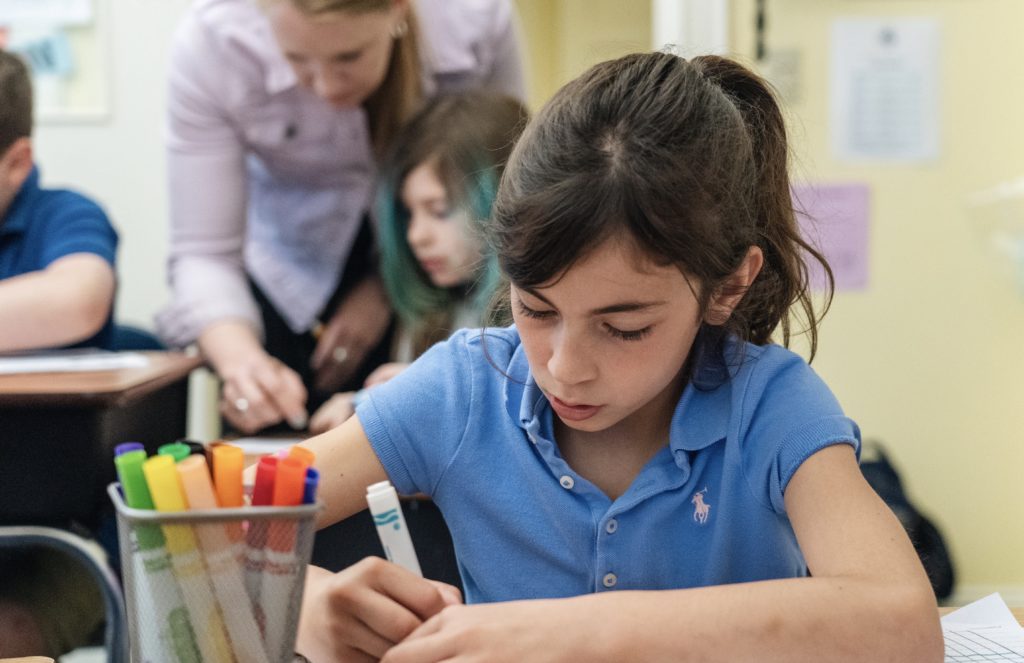“ I tried very hard to be normal…I tried to hide as much as I could…You think you go day by day…but…it’s like every day is a full lifetime. And it’s like “Oh my god! I have to get through this…the amount of anxiety, stress, and fear is enough to fill a lifetime…it is just so stressful…once I go to bed, it is like the end of my life…” (Cole, 18)
As a student with LBLD, Cole knows better than most, what living with anxiety means. Indeed, the literature reports that rates of anxiety are significantly higher for students with learning disabilities. While the reasons for this remain unclear, students with LBLD connect their increased stress level to a number of factors. The difficulty of performing daily school tasks, as Cole describes, may certainly trigger a constant state of hyper-vigilance. Emily, 18, shares the same worry: “they would go around the room and have us read. I remember chewing on my sleeves because I was so nervous about being picked.” The acute sense of being different, described by many of our students as beginning in Kindergarten or 1st grade, often tightens the grip of that anxiety. “…I was so self-conscious about my learning and comparing myself to other kids…I would put myself down because I felt I was not as smart as the other kids” (Emily, 18).
That anxiety may lead to school refusal. Many students with LBLD also describe an intense preoccupation with friendships. “Once I started having problems in the classroom, I became more shy, and I focused so much on having friends…even as a 6 year old, I was worried about socializing…” That worry may spread to social anxiety: “As I got older…I would get anxiety about getting anxiety. I would not want to go to social events…in my freshman or sophomore year, I could not even eat at the cafeteria” (Emily, 18)
Students with anxiety tend to be acutely sensitive to negative comments about their academic struggles. Remarks “that I was not trying hard enough and I was not going to do anything with my life” (Jessica, 15), tend to decrease their motivation to even try. School interventions to address the LBLD, even if well intentioned and effective, may also have unintended consequences on their sense of self and their peer interactions, thus increasing their anxiety. “Getting taken out of class, taking tests in separate rooms, and having an aid walk up my way more often than she would to other people…things like that single you out…I guess seeing that made them think that there was something wrong with me, and they wouldn’t think that I could play sports with them, or do the same kinds of arts and crafts…just because they thought I was different.” (Mike, 18)
Beyond its influence on motivation and the quality of life for students with LBLD, anxiety often has a direct impact on their ability to learn. It may significantly interfere with attention, focus, memory and ability to think and problem solve. Therefore, it is essential for educators to foster a classroom environment that will minimize anxiety, as well as help students develop strategies to cope with their fears.
What might teachers see?
The first step is for educators to recognize anxiety, as it presents itself in a variety of ways in the classroom. Here are some behaviors exhibited by students attempting to manage anxious feelings.
- Checking: Students may repeatedly look over their work, even erase it, and start over.
- Repetitive actions: Students may compulsively touch their hair, fidget, pick, or display other tics.
- Need for reassurance: Students may ask the same question over and over to clarify and ensure they understand in order to calm their anxious thoughts.
- Helplessness: Students may voice that they are unable to do something: “I can’t handle it,” “please help me,” “do it for me.” Their anxiety is preventing them from seeing their ability or from taking the risk to attempt a task.
- Passive or Active Opposition: These behaviors are more difficult to recognize as anxiety driven. Students might create their own barrier to avoid work by not following directions, refusing, arguing in order to get out of the scary task.
- Avoidance: Task avoidance is a typical response to anxiety. It is most often unconscious and automatic, and impedes the child’s ability to initiate and carry out academic assignments at home or in school. Students may be explicit, saying “no way I’m doing that,” or “I can’t”. They may show more subtle avoidant behaviors such as fidgeting, going to the nurse, sharpening their pencil, or asking to use the restroom, in order to avoid the task that is triggering the anxiety. This can even include escape behaviors where students refuse to return to class. They will procrastinate doing their homework or studying for an exam, and then, feel overwhelmed by the enormity of the task at hand when facing the deadline.
What can teachers do about it?
Anxious children do best in environments that are predictable and safe. Reviewing the agenda at the beginning of class and writing it down on the board is helpful. For students to know when they will be called upon to answer a question so they can prepare themselves also makes a difference. The educator’s ability to maintain a calm, predictable demeanor, is essential. Out of a desire to help, teachers may become overly supportive when they notice anxious behaviors. They may reassure constantly, overprotect, accommodate too much in an effort to avoid upsetting the child, or they may rush to fix the problem. Others may adopt a “tough love” stance; they may become harsh and demanding. Often times, teachers find themselves vacillating between those two approaches. What is in fact most helpful is to find a balance of structure and support. Expectations should be maintained, and students need to be pushed to work through the anxiety and continue the task, despite their worry. They should be presented with support to feel that they are capable and safe in attempting the worrisome task. Here are some ways to be supportive and still hold a student to the expected standard:
- Set the student up for success: help students to understand that the task you are presenting them with is doable, and that you only set them up for success. That does not mean that the path will be easy, but that you will support them to complete the work to their ability level.
- Use multiple modalities: students with anxiety often benefit from having a task that is movement based or sensory. This can help to regulate the body and diffuse the feeling of anxiety.
- Check back for understanding: Given that students with anxiety may often request clarification, ask them to repeat directions, or to provide their answer to your inquiry before they put pen to paper or complete the task. This will give them a feeling of confidence or capability when beginning a task. A variation is to request that another student repeats directions for the whole class, to avoid focussing on the anxious student.
- Micro-unit the work: Students with anxiety benefit from the work being broken into more manageable chunks. This way they can feel success upon completion of portions of work and reflect on this success to combat feelings of anxiety moving forward.
- Help students get comfortable with feeling uncomfortable: When you encounter students’ anxiety with regards to school tasks, remember that threats and angry demands are counterproductive and typically lead to the opposite result because students become more anxious, feels misunderstood, and are resentful. Instead, we need to remind students that discomfort is ok and help them get used to the feeling of discomfort as a sign that they are learning and growing.
- Channel calm: Your ability to remain calm and model calm under pressure is more likely to foster a similar attitude in your students.
What can kids do about it?
Procrastination and avoidance are the “go to” responses for students with anxiety, even though they may not be aware of their automatic reaction to stressful tasks. Unfortunately, it leads to the child’s increasing fear since the fear is never “faced.” There are different ways of countering this tendency; here are some strategies to use with your students.
- Help them learn how to manage the workload. This may involve decisions about the order in which to tackle the assignments (from easy to difficult, or the opposite, or according to class order). Also break down the task into manageable units and have the student praise themself for completion.
- Change the perception of their LBLD so that they see it as a manageable issue. Kids with LBLD develop self-defeating thought processes that prevent them from even attempting work. With help, students can learn to identify those thoughts and counter them. Whenever she made a mistake, Rose’s mind would spin out of control: “ I am so dumb, I will never be able to learn this, I will not go to college, and I will end up working at McDonald’s for the rest of my life.” She would rip up her work, and walk away. When the self talk changes, than the behaviors can change too. Encourage students to talk to their anxiety and help them form positive responses like “I can do this, I’ve been able to before” or “I can try this and then ask for help if I’m unsure.” As Emily says, “when you are thinking and putting yourself down, like that I am dumb…you notice…” Instead, students can remind themselves that they are smart, that they succeeded before and can again.
- Encourage their use of distraction to shift the thought process. Students with anxiety often get stuck in a “hamster wheel” of worried thoughts. At times there is no using logic to get out and instead, distraction can be a useful technique to calm the anxiety. One student mentions “I like to go outside so I can feel not trapped or [I] listen to music and tune out to the beat of the song.” (Nicole, 17). An elementary student prefers to “… watch funny Youtube videos or look at a picture of my dog to help distract my brain…that puts it on track.” (Jessie, 10).
- Support their practice of breathing exercises, mindfulness, and muscle relaxation to counter the anxious mindset and calm the fear response. Jessie shares “when I worry, I use my calm app to listen to rain sounds and practice breathing.” A high schooler notices “muscle relaxation…[for] when you feel you have the body symptoms…helped a lot with anticipatory anxiety I had before public speaking or if I had a race…it helps your body relax…it helps your head.” Students who take part in mindfulness at the start of each day at school notice that they are able to reset or take a quick “nap” to quiet their mind before class and that they can tap into this feeling before a test, or when their worries flare up.
- Remind students to reach out for support. Sometimes anxious feelings are so strong that students need to talk to a trusted adult or peer to practice one of the strategies above, or have validation that their worry makes sense, but still does not need to be taking over. Students who are really feeling stuck and might need adult support, could find it helpful to take a walk or get a drink, as an additional way to reset the body so that the mind will reset too.
- Lastly, it is worth mentioning that anxiety may be so overwhelming that students cannot access their internal resources and help themselves. A referral to a counselor or school psychologist may be indicated.
These strategies will help teachers feel in better control of their classroom and be more effective in helping students who are well versed in what it is like to live with both a learning disability and anxiety. Educators will be able to witness their students become increasingly successful in taking on challenges, which will help them go on to be resilient, creative adults with fulfilling lives.
References
- Alesi M, Rappo G, Pepi A (2014) Depression, Anxiety at School and Self-Esteem in Children with Learning Disabilities. J Psychol Abnorm Child 3:125. doi:10.4172/2329-9525.1000125
- Harvard Medical School
- Kearney CA. School absenteeism and school refusal behavior in youth: a contemporary review. Clin Psychol Rev. 2008;28(3):451–471. doi: 10.1016/j.cpr.2007.07.012.
- Robinson, O. J., Vytal, K., Cornwell, B. R., & Grillon, C. (2013). The impact of anxiety upon cognition: perspectives from human threat of shock studies. Frontiers in human neuroscience, 7, 203. doi:10.3389/fnhum.2013.00203



